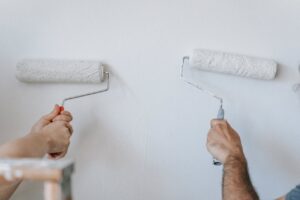
10 Steps in Choosing the Right Drywall Repair Service: A Step-by-Step Guide
Choosing the right drywall repair service can be a pivotal decision for homeowners seeking to maintain the integrity and aesthetics of their living spaces. The process involves more than just a quick internet search; it requires careful consideration of various factors to ensure that you select a service provider that meets your specific needs. In this detailed guide, we will explore the ten essential steps to help you make an informed decision when choosing a drywall repair service. Step 1: Assess Your Repair Needs Before diving into the selection process, it’s crucial to assess the specific repair needs of your drywall. Identify the extent of the damage, whether it’s cracks, holes, water damage, or other issues. Understanding the scope of the repair will enable you to communicate effectively with potential service providers and ensure they have the expertise to address your particular concerns. Step 2: Research Local Service Providers Start your search by compiling a list of local drywall repair service providers. Utilize online platforms, local directories, and recommendations from friends or family to create a comprehensive list of potential candidates. Researching multiple options gives you a broader perspective and allows you to compare services, pricing, and customer reviews. Step 3: Verify Licensing and Insurance Once you have a list of potential candidates, verify their licensing and insurance credentials. A reputable drywall repair service should be licensed to operate in your area, and they should have liability insurance to protect you in case of any accidents or damages during the repair process. Request this information from each service provider and ensure it is up-to-date. Step 4: Check References and Reviews Customer references and online reviews are invaluable resources when evaluating the reputation of a drywall repair service. Reach out to the service providers on your list and request references from past clients. Additionally, check online review platforms to gather insights into the experiences of other homeowners. Consistently positive reviews and satisfied customers are indicators of a reliable and trustworthy service. Step 5: Inquire About Experience and Expertise Not all drywall repair services are created equal, and experience matters when it comes to ensuring a high-quality outcome. Inquire about the experience of each service provider on your list, focusing on their expertise in handling the specific type of drywall damage you have. A seasoned professional is more likely to accurately diagnose issues and provide effective solutions. Step 6: Request a Detailed Quote Contact the remaining candidates on your list and request a detailed quote for the drywall repair work. A comprehensive quote should include a breakdown of costs, materials, labor, and any additional fees. Be wary of vague or overly simplified estimates, as they may lead to unexpected costs down the line. A transparent and detailed quote is a sign of professionalism and accountability. Step 7: Assess Communication and Customer Service Effective communication is crucial throughout the repair process, from the initial inquiry to the completion of the project. Assess the responsiveness and communication style of each service provider. A reliable drywall repair service should be attentive to your inquiries, provide clear explanations, and keep you informed at every stage of the repair process. Good customer service is a key indicator of a service provider’s commitment to client satisfaction. Step 8: Evaluate Work Guarantees and Warranties Reliable drywall repair services often provide guarantees or warranties for their work. Inquire about the terms and duration of any guarantees or warranties offered by the service providers on your shortlist. A commitment to standing by their work demonstrates confidence in the quality of their repairs and provides you with added assurance in case any issues arise after the completion of the project. Step 9: Confirm Project Timeline Understanding the expected timeline for your drywall repair is essential for planning and coordination. Inquire about the projected start and completion dates for the repair work from each service provider. A reliable contractor should be able to provide a realistic and transparent timeline based on the scope of the project. Timely completion is a testament to their efficiency and commitment to client satisfaction. Step 10: Compare and Make an Informed Decision After completing the previous steps, compare the information gathered from each service provider. Consider factors such as experience, reputation, communication, pricing, and guarantees. Make an informed decision based on a holistic evaluation of these factors, ensuring that the chosen drywall repair service aligns with your specific needs and expectations. Conclusion Choosing the right drywall repair service is a crucial step in maintaining the structural integrity and aesthetic appeal of your home. By following this comprehensive 10-step guide, you can navigate the selection process with confidence, ensuring that you partner with a reputable and reliable service provider. From assessing your repair needs to making a well-informed decision, each step plays a vital role in ensuring a successful and satisfactory drywall repair experience. Is Your Home in Need of Expert Drywall Repair? Introducing Paintmasters, Concord, California’s premier professionals in home renovation and drywall repair. Since 1994, we’ve been revitalizing living environments, from cozy residences to dynamic commercial spaces. Our approach to drywall repair goes beyond mere patchwork; it’s about meticulously preparing your space for a seamless and polished finish. Equipped with advanced tools and techniques, we ensure results that are not only visually appealing but also enduring. At Paintmasters, our services extend beyond basic fixes. We provide comprehensive solutions that include thorough preparation processes such as sanding, sealing, and precise drywall repair, ensuring your walls are impeccably restored before any further work is done. Our skilled team, with their extensive experience in various aspects of home renovation, is dedicated to rejuvenating and transforming your space, giving it a fresh and renewed appearance. We’re committed to achieving excellence from the outset, offering you a smooth and satisfying home renovation experience. Are you prepared to revitalize your home with expert drywall repair? At Paintmasters, we’re not just about fixing walls; we’re about creating an atmosphere of quality and sophistication. Contact us today to embark on your journey to a

